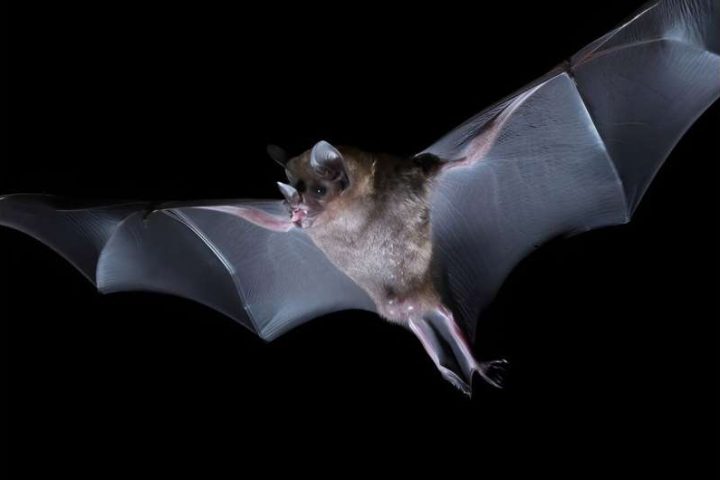A new study by researchers at Goethe University Frankfurt delves into the fascinating world of Seba’s short-tailed bats, known for their lively social gatherings and impressive echolocation skills. These tiny mammals, found in Central and South America, navigate their tropical and subtropical forest homes using a combination of vocal communication and echolocation.
Partying with a Twist:
These bats aren’t just hanging out in their caves and hollowed-out trees. Their vocalizations create a constant buzz, resembling a lively party atmosphere. But this isn’t just about socializing – these sounds also play a crucial role in navigating their surroundings.
Echolocation: Seeing with Sound:
Seba’s short-tailed bats are masters of echolocation. They emit high-frequency sounds that bounce off objects, creating an “acoustic image” of their environment. This allows them to navigate in the dark and locate food sources.
Filtering the Noise:
But how do these bats manage to pick out important sounds from the constant chatter of their own colony? Researchers believe the brain plays a key role, acting like a filter. The brain “predicts” what sounds are coming next and focuses its attention on unexpected noises, allowing the bats to distinguish important signals from the background noise.
Understanding the Mechanism:
Scientists are now exploring the mechanisms behind this “deviance detection” process. Their findings could shed light on how the brain filters information in noisy environments, potentially informing future applications in areas like noise cancellation technology.
Bats Process Meaningful Sounds Differently in Brainstem
Building upon their previous research, the team at Goethe University Frankfurt has taken a significant step forward in understanding how Seba’s short-tailed bats filter sound. Their latest study, published recently, investigated how the brainstem, a region traditionally associated with basic functions, processes natural communication and echolocation calls.
Beyond Artificial Stimuli:
Previously, the researchers demonstrated that signal processing begins in the brainstem, not just higher brain regions. However, those studies used artificial stimuli unrelated to the bats’ natural environment. This new research aimed to bridge this gap by using natural communication and echolocation calls.
Listening While Asleep:
To record brain activity, the team carefully inserted thin electrodes under the bats’ scalps while they were under general anesthesia. This ensured the recordings wouldn’t be affected by movement. Interestingly, the bats’ brains still responded to sounds even while anesthetized.
Echolocation vs. Communication:
The researchers presented the bats with either echolocation or communication calls, each interspersed with the other at a 10% probability. By analyzing the brain waves, they observed a fascinating difference in how the brainstem processed these sounds.
Echolocation and Deviance Detection:
As expected, infrequent echolocation sounds triggered stronger brain signals compared to frequent ones, confirming the deviance detection mechanism previously observed. This suggests the brainstem prioritizes unexpected echoes, potentially aiding navigation.
Communication Calls: A Different Story:
However, the brainstem response to communication calls did not depend on their frequency. This implies that the brainstem might treat communication calls differently, potentially reflecting their continuous nature within the colony and the need for constant monitoring rather than focusing on specific, infrequent events.
Unveiling the Brainstem’s Role:
This study provides compelling evidence that the brainstem plays a crucial role in processing both echolocation and communication calls in Seba’s short-tailed bats. While the processing of these calls differs, the findings highlight the brainstem’s surprising complexity and its involvement in higher-order functions beyond just basic survival needs.
Future Implications:
Further research into how the brainstem differentiates between different sound types could offer valuable insights into sensory processing and information filtering in noisy environments. This knowledge could potentially have applications in various fields, including developing improved noise cancellation technologies or understanding how other animals navigate complex auditory landscapes.
Brainstem’s Speedy Response: Key to Echolocation
Professor Kössl suggests that the faster reaction to infrequent echolocation calls compared to communication sounds might be due to the bats’ need for quicker response during navigation. The brainstem, being the first point of entry for these signals, could be crucial for calculating the probability of echolocation calls, especially their echoes, allowing the bats to react swiftly and avoid obstacles. This stronger response might be linked to better synchronization of neurons in the brainstem.
Beyond Frequency: Brainstem’s Hidden Talents
The study revealed another surprising finding: the brainstem’s ability to utilize features beyond just frequency for deviance detection. It can identify changes in pitch, volume, and potentially other characteristics of bat calls. This challenges the traditional view of the brainstem as a simple relay station for auditory information. Wetekam emphasizes this shift in understanding, highlighting how scientists previously believed the brainstem’s role was limited to receiving signals and passing them on, not actively processing them.
Implications Beyond Bats:
These findings could have broader implications beyond understanding bat biology. They suggest that studying lower brain regions, like the brainstem, might be crucial for comprehending complex neurological disorders in humans, such as ADHD and schizophrenia, which involve difficulties in filtering out irrelevant stimuli. Additionally, understanding how the brainstem processes complex sounds in bats could shed light on how the human brain deciphers and interprets the intricacies of human speech.
This research by the Goethe University Frankfurt team significantly advances our understanding of how Seba’s short-tailed bats filter sound. It reveals the brainstem’s unexpected role in processing both echolocation and communication calls, highlighting its involvement in complex auditory tasks beyond basic functions. The study’s findings not only offer insights into bat biology but also hold potential for broader applications in various fields, from developing better noise-canceling technologies to understanding human neurological disorders and speech processing.
The findings are published in The Journal of Neuroscience.



